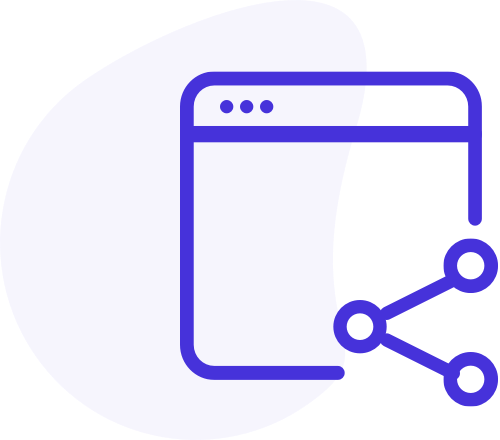Lana Andreeva
April 14, 2022
Oh, that very familiar feeling of awkwardness when you start a conversation with a person you want to convince to buy something from you. As part of any inbound lead generation conversation, you want to establish some rapport, but what should your process look like?
Well, you probably checked their LinkedIn profile, their company’s website, or a few news pieces on the Internet. And you don’t want to be perceived as an “that awkward salesperson”. What do you do then?
Here are a few tips!
Don’t try to sell from the very first minute
Let me say it up front: sales meetings are not about you and your product. They are all about a prospect’s issues you may help solve. So, make sure you are not jumping on a call with them with a “Buy from me, buy from me” kind of pitch at the ready.
Whether you’re speaking over the phone or engaging in email lead generation the best advice we can offer here is to be as genuine as you are in your out-of-sales life.
Imagine those conversations you had with your friends last week – I bet you were nice and genuine and funny. Try to be like that on your calls with prospects.
Why does it work? Everyone wants to feel you are interested in them not because of money they might pay you in the future, but because of who they are and what they have to say.
Stop avoiding small talk
I know, I know … you are rolling your eyes now. Everyone seems to be obsessed with small talk, but at the same time everyone hates it. That is because many of us just don’t really know how to manage. Jessica Magoch, a startup sales coach, is sure that small talk is the key. Her advice is: “Allow the chit chat to go on for as long as possible, and let the customer decide when to get to business.”
That is crucial, since – again! – sales meetings are about your potential customers and not about you. You obviously want to sell your product, but you also want to be trusted.
According to Forbes, we all hold more appreciation for these quick, casual conversations than ever before, especially in a post-COVID world.
Why does it work? Business is being built on a solid foundation of trust. You sell trust, then you sell the product. Not the other way around.
Be observant
This is a great sales meeting icebreaker. It’s actually a great icebreaker for any conversations with people you have just met or have not talked to for a long time. Especially amid these Zoom times.
But how can you accomplish such an easy back-and-froth? You can simply comment on something someone is wearing. It always works. Those hockey team t-shirts, a funny hoodie, or whatever.
What else? You can comment on something in their background.
Like the point above about small talk, observing something about the person you’re talking to leads to more familiarity and comfort. Like – Wow, you have got such a huge library! or You must be a sportsperson? I see lots of trophies on your shelves. I see your amazing collection of guitars, by the way, my little sister is a great player.
Why does it work? It helps you build trust. And trust is the key when you are selling. People start to feel connected with you when you allow them to share some stories about themselves (everyone likes to talk about themselves, just embrace it – and let people talk).
Point out to something you already know
Before jumping on a call with a prospect, make sure you did your homework. Look through their social media – say LinkedIn, read some posts, check their job title, and so on. Be prepared. Maybe that person just launched another business?
Maybe their company has been generously funded by an investor you previously read a few words about? Bring that up. Ask questions.
Why does it work? Again, people love to talk about themselves. It’s just our nature. Also, it gives you a chance to show that you came to this meeting prepared and not knowing next to nothing about the person you are speaking with.
Talk about current events
There are lots of them. A week ago, I saw pictures of the most recent snow storm that hit New York City. You know, all those pictures – enormously big snowdrifts, people trapped in their offices, insane traffic jams … A few days later, I had a Zoom meeting with someone from New Jersey.
I started with “Oh, you know, I just saw the recent pics from New York, that is insane! Looks like you have recently got tons and tons and tons of snow”. Boom! That person was complaining about the weather for a good two minutes.
This might be any other topic. A festival that took place in their city, or holidays – remember it’s okay to say “Happy New Year!” until it’s February. Just please try to stay away from political topics. These are reserved for your family and parties with friends.
Why does it work? It’s all about connection. During that meeting you are trying to build a trustworthy relationship, not only sell a service or product.
Listen to your prospect
Conversations are not only about talking, they are also about your ability to listen. You use all those icebreakers in order to get people talking about their business challenges and issues. And you need to be a great listener.
One of the most important journalist rules says: Ask open-ended questions. If you want to get an answer that is more in-depth than “yes” or “no”, ask them questions that allow them to be more detailed.
And make sure you listen to what they are saying. Ask “What challenges have you been facing?” instead of “Was the last year bad or good for you?”
Why does it work? It allows people to share their thoughts and issues first. And – if you listen carefully enough – you might be able to get some valuable information.
Mirror a person you are talking with
I mean what I say. Mirroring is mimicking your client’s behaviour. Maybe the repetition of some key words they tend to use when describing themselves or their business or some of their most common gestures. It is not about playing the ape. It is about building a strong bond between you and them.
It’s a practice that is helping establish empathy and trust for more and more business minds. This tactic is being used by Chris Voss, an American entrepreneur and a former FBI hostage negotiator. So, he obviously knows what he’s doing.
Why does it work? It creates a commonality between you and your prospect. On an unconscious level, it creates a connection between you, which leads to a deeper connection.
Easy, right? Be genuine, listen carefully, and ask deliberate questions. These are actually the basic rules of our normal day-to-day communication.









